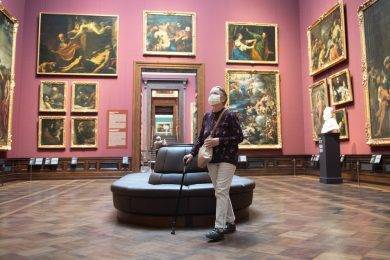Many museums and exhibitions offer virtual tours. What is the point of going to the museum when you have everything to carry mice? How do you feel a work vibrate on a small, flat and cold screen? For example, I told you about the Sonia Delaunay exhibition, and I cannot ignore the Google Art Project, which has digitized many works of art. Today, I compare the pros and cons of going to the museum in real life or virtually. Points are counted on different criteria: cost, duration, experience and many others.
The Cost
From the Internet, we will consider that it is free in the majority of cases. For a visit to a museum or an exhibition, it usually takes a good ten euros. On the “cost” criterion: 1 point for Internet
The Duration
On the Internet, we will discover an exhibition, check our emails, drink tea, and do many other things. We are rather in zapping mode. It can be handy for a quick break while in the office. The visit to the museums will involve us fully for at least an hour, not even counting the transport. Who to award the point to? The one who offers us a longer distraction? Which one gives us the most flexibility? So 1 point everywhere.
Interaction
On the Internet, we will be able to learn as we go, deepen a subject that we discover, by going to other sites. The sources of information are thus multiplied. In an exhibition, we follow an itinerary and a demonstration proposed by the curators. The written signs inform us according to this demonstration. If you want to know more, you take out your smartphone to go online.
So without hesitation, 1 point for the Internet
Contact with the arts
On the net, contact with the arts is formatted. The photo is taken from an angle that aims to be “objective”, the light is controlled, even rectified. The tables are all the same size. There is no relief. On the other hand, the interest is to be able to zoom in on details, which go unnoticed in reality. By observing art in real life, one can feel immersed in an oversized painting, or on the contrary perceive the smallness of the work. Take the Mona Lisa at the Louvre: we realize that the size of the painting is modest. On a daily basis, we see it in enormous dimensions on advertisements for example. The impression is completely different. This point obviously goes to the in situ visit to a museum
The Experience
On the net, browsing will give rise to a few “likes” at most, which will remain from this moment. In real life, maybe you will have shared a moment with someone. You will remember the context (it was sunny, cold, my feet hurt, etc.). Your whole body will have experienced and recorded this visit. You will understand, it is 1 point for the real visit for the complete experience.
The Surprise
Either way, you will not be immune to surprise. The unexpected can happen at any time, in different forms. That is what I love when I discover art.
Tied on this criterion: 1 point everywhere
Conclusion, the winner is
The real museum.
No surprise when the Internet cannot replace direct contact with works. Above all, exhibitions and museums offer a reading of art, of context. This axis of understanding is present in the arrangement of the works and tells us a story. This aspect is often non-existent on the Internet; the reading of the works will be approached differently. However, I do not denigrate the richness of the Internet, which allows us to discover things without physical limits.
I am Jones Smith and I am here to share my experience and expertise in writing. I’ve been writing articles for different publications for more than 6 years. I have a varied range of interests and that’s why I love blogging about different topics. In my opinion, blogging is a lot like acting, and I consider writing blog posts as an acting job. I am an entrepreneur by heart and there is nothing big or small when it comes to starting a business.











